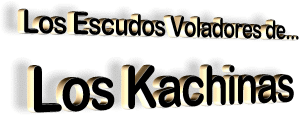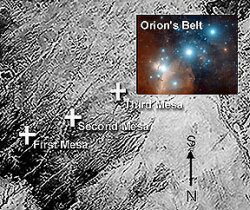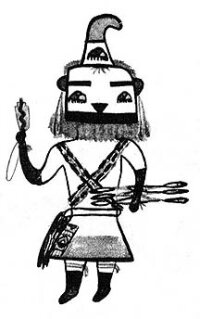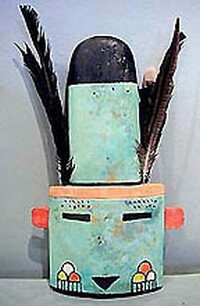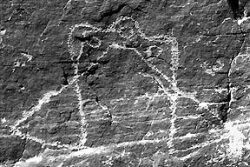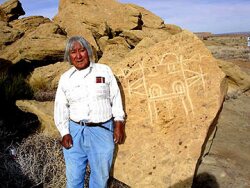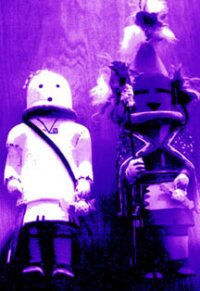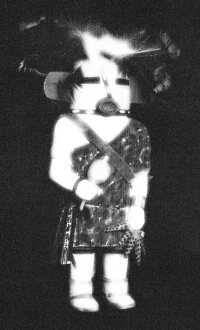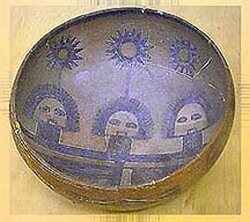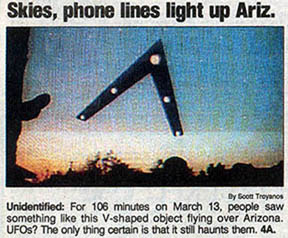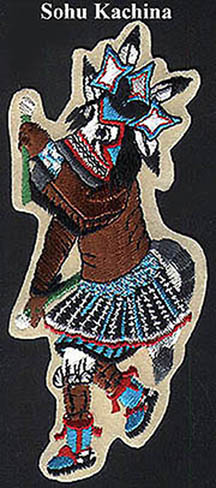|
|
|
2008
Las antiguas máquinas voladoras han sido por mucho tiempo una tradición de varias culturas en todo el mundo.
Venerables textos hindúes como el Ramayana y el Mahabharata describen aeronaves llamadas Vimanas que hasta fueron utilizadas para la batalla.
Entre los jeroglíficos sobre la pared de un templo egipcio de 3.000 años de antigüedad, en Abydos, hay representaciones de lo que parecen ser aviones modernos y helicópteros.
Discos de piedra acanalados
encontrados en cuevas en la frontera chino-tibetana cuentan de una
raza extraterrestre llamada los Dropas cuya nave espacial llegó a la
Tierra hace 12.000 años.
Los Hopi pueden haberse establecido en las tres colinas principales de Arizona
porque quisieron
reflejar su constelación de origen.
Estos mágicos escudos voladores llamados paatuwvota existieron en el Tercer Mundo, una era anterior destruida por un inmenso diluvio. Ésa fue la época en que se construyeron las grandes ciudades y rutas de comercio, y la civilización estaba floreciendo.
En una alocución ante las Naciones Unidas, Thomas Banyacya del clan Hopi Coyote dijo:
Nosotros,
claro, reconocemos esta sorprendente descripción como un eco de la
Atlántida.
Llevaba un traje que relucía como el hielo (¿un traje espacial metálico?) en tanto que su cabeza y cara brillaban como una estrella.
El ser habló:
Dibujo Hopi del dios del cielo Sotuknang.
Él los subió entonces sobre su escudo volador bien alto en el cielo de manera que ellos pudieran ver así por muchas millas alrededor.
Dándoles de comer melones maduros a los niños hambrientos, el ser les dijo que debían tener fe en él y en sus enseñanzas que llegarían después a través de sus sueños. Finalmente, aterrizó a corta distancia del pueblo en que su madre y su padre se habían establecido, y despidiéndose de los jóvenes, voló de nuevo hacia las nubes.
Agradecidos por siempre con el dios del cielo, el hermano y la hermana caminaron hasta el pueblo para reunirse con sus padres.
Máscara de Sotuknang.
Ya que los Hopi no tenían ninguna cosa tal como un platillo, volador o de otra clase, ellos lo denominaron según el atavío cultural más cercano a esa forma, a saber, el escudo del guerrero.
La palabra tuwvota significa este tipo de escudo específicamente. Por extraño
que parezca, el concepto de la guerra en la ideología de los Hopi
está relacionado con las estrellas. El uso de tuwvota en lugar de la
palabra más común para “disco” o “círculo” hace pensar por lo tanto
en un origen celestial para el paatuwvota.
Además, el prefijo pa - denota “maravilla” o “temor”.
Para la gente del desierto, “maravilla” equivale a “agua”, pero pa -
quizás hace pensar en la reacción ante este extraordinario medio de
transporte.
¿Petroglifo de una nave espacial ala-delta?
En su libro Mexico Mystique, Frank Waters, un experto no indio en los Hopi, escribe:
Algunos lectores pueden estar familiarizados con las muñecas de madera kachina que tallan los Hopi. (ver la fotografía.) Los Kachinas no son dioses en sí sino espíritus que actúan como mediadores entre los dioses y los humanos. Ellos pueden tomar la forma de cualquier animal, planta, cuerpo celestial, o criatura de otro mundo.
Durante la primavera y principios del verano los Hopi realizan un ciclo ceremonial de bailes de máscaras kachina como una súplica por la lluvia y el bienestar general de la tribu.
Eototo, jefe Kachina (izquierda) y Aholi, su lugarteniente.
Muy parecidos a los ángeles caídos (o los vigilantes) de la Biblia (ver
Génesis 6:1-4), los Kachinas fueron a veces conocidos por aparearse
con las mujeres Hopi. Esto prefigura el tema contemporáneo de la
abducción alienígena con el propósito de reproducción.
Muñeca Kana kachina.
Este pasaje se tomó de un libro llamado Earth Fire: A Hopi Legend of the Sunset Crater Eruption escrito en co-autoría por Ekkehart Malotki, un profesor, blanco, de idiomas de la Universidad de Arizona del Norte, y Michael Lomatuwayima, un Hopi de de Hotevilla, la aldea sagrada de la Tercera Colina .
El Kana Kachina está
asociado con la erupción volcánica que empieza en el 1064 AD que
creó el ahora extinto Sunset Crater localizado cerca de San
Francisco Peaks. Otras sesenta millas más al nordeste, una gran
piedra rectangular debajo del pueblo de Mishongnovi también es
conocida como “la casa del Kana Kachina”.
Este variado grupo de
mensajeros divinos debe de haber sido una hermosa vista. De hecho,
los Hopi a veces se refieren a los kachinas como “las hermosas
criaturas” Esta designación no sólo da énfasis a su apariencia
estéticamente agradable sino también a su papel como entidades
reales en un sistema de parentesco.
Su presencia había sido claramente física o tangible como opuesto a lo sobrenatural o etéreo.
En otras
palabras, su influencia se sentía directamente a un nivel material.
Cuando el tiempo siguió, sin embargo, la corrupción social y
religiosa - un tema recurrente en el pensamiento Hopi – obligó a
estas raras pero benévolas “personas” a abandonar el sudoeste
americano. Desde ese período hasta el presente, los kachinas
aparecen en la mayor parte sólo en forma de espíritu.
De entre los restos, ellos rescataron
a un alienígena plateado, inconsciente pero todavía vivo, a quien le
dieron el nombre de Estrella Mayor. Después de que lo cuidaron hasta
que se repuso, el ET les describió entonces telepáticamente por
medio de un cristal la guerra galáctica que había derribado su nave
espacial. Este material de Expedientes-X relacionado con un
americano nativo permanece no confirmado.
En el verano de 1970, cientos de UFOs fueron vistos a unas 125 millas al sudoeste de las aldeas Hopi cercanas a la ciudad de Prescott, Arizona.
En la tarde del 13 de marzo de 1997, en la misma vecindad una nave ala-delta, quizás como de una milla de largo, cruzó con las luces encendidas en sus bordes anteriores, flotando silenciosamente antes de acelerar hacia el sur.
Esto se conoció luego como las
Luces de
Phoenix.
Ellos también dijeron que durante el Fin de los Tiempos nosotros seríamos visitados por “la gente de afuera” de la Tierra que tiene una tecnología avanzada.
Trío de estrellas mayores, cuenco cerámico, Arizona del Norte.
Muchos guardianes de la sabiduría Hopi creen que el aumento de la presencia de escudos voladores señala el fin del Cuarto Mundo, o nuestra era actual.
Junto con las profecías bíblicas del Apocalipsis, los Kachinas o superiores de las estrellas pueden estar intentando advertirnos de este grave estado de cosas. Escuchando a estas entidades a lo largo de las eras, los Hopi que viven en sus colinas aisladas han sabido desde hace mucho tiempo sobre el destino global que ahora parece inminente.
Algunas de las señales y presagios están en los cielos.
Nosotros sólo necesitamos verlas.
The Hopi Kachinas 2008 from MondoVista Website
Ancient flying machines have long been a tradition of many cultures across the globe. Venerable Hindu texts such as the Ramayana and the Mahabharata describe airships called Vimanas that were even used for battle.
Among the hieroglyphs on the wall of a 3,000 year-old
Egyptian temple at Abydos are depictions of what appear to be modern
airplanes and helicopters. Grooved stone discs found in caves on the
Chinese-Tibetan border tell of an extraterrestrial race called
the Dropas whose spacecraft fell to Earth 12,000 years ago.
The Hopi may have settled on the three primary mesas in Arizona because they wanted to reflect their star elders' constellation of origin.
This was a
time when great cities and trade routes were built, and civilization
was flourishing. In an address delivered to the United Nations,
Thomas Banyacya of the Hopi Coyote Clan said: "The people invented
many machines and conveniences of high technology, some of which
have not yet been seen in this age." We, of course, recognize this
startling description as echoing Atlantis.
He spoke:
Hopi drawing of the sky god Sotuknang.
He then took them on his flying shield up into the sky so that they could see for many miles around.
Feeding the hungry children ripe melons, he told them that they must have faith in him and in his teachings that would later arrive through their dreams. Finally he landed a short distance from the village in which their mother and father had settled, bid the young ones farewell, and flew up again into the clouds.
Forever grateful to the sky god, the brother and sister walked into the village to be reunited with their parents.
Mask of Sotuknang.
Because the Hopis had no such thing as a saucer, flying or otherwise, they named it after the cultural accouterment closest to that shape, namely, the warrior's shield.
The word tuwvota
specifically signifies this type of shield. Oddly, the concept of
war is connected in Hopi ideology with the stars. The use of tuwvota
rather than the more common word for 'disk' or 'circle' thus
suggests a celestial origin for the paatuwvota
Petroglyph of a delta-winged spacecraft?
next to petroglyph, possibly depicting a "flying shield."
In his book Mexico Mystique, Frank Waters, a non-Indian expert on the Hopis, writes:
Some readers may be familiar with the wooden kachina dolls that the Hopis carve. (See photo.) Kachinas are not gods per se but spirits that act as mediators between gods and humans. They may take the form of any animal, plant, celestial body, or otherworldly creature.
During the spring and early summer the Hopis perform a ceremonial cycle of masked kachina dances as a plea for rain and the general well being of the tribe.
Eototo, chief kachina (left) and Aholi, his lieutenant.
The Hebrew word for "officer"
in the Bible is katsin.
Much like the fallen angels (or the Watchers) of the Bible (see
Genesis 6:1-4), the kachinas were sometimes known to mate with Hopi
women. This prefigures the contemporary theme of alien abduction for
the purpose of reproduction.
Kana kachina doll.
This passage is taken from a book called Earth Fire: A Hopi Legend of the Sunset Crater Eruption co-authored by Ekkehart Malotki, a white professor of languages at Northern Arizona University, and Michael Lomatuwayima, a Hopi from the Third Mesa shrine-village of Hotevilla.
The Kana kachina is associated with the volcanic eruption starting in 1064 AD that created the now-extinct Sunset Crater located near the San Francisco Peaks.
Another sixty miles farther
northeast a large rectangular rock below the village of Mishongnovi
is also known as 'the house of the Kana kachina.'
As time went on, however, social and religious corruption -- a recurring motif in Hopi thought -- forced these bizarre but benevolent 'people' to abandon the American Southwest.
From that period to the present, kachinas appear for the most part only in their spirit forms.
From the wreckage they recovered a silvery
alien, unconscious but still alive, whom they named the Star Elder.
After they nursed it back to health, the ET then telepathically
described by means of a crystal the galactic war raging above which
had downed its spacecraft. This X-Files material with a Native
American twist remains unconfirmed.
It later became known as the Phoenix Lights.
USA Today headline, June 18th, 1997.
In 1998 the radio talk-show host Art Bell interviewed two Hopi elders who stated that their very distant ancestors knew how to travel to other planets.
They also said that during the End Times, we would be visited by 'people outside' the Earth who have an advanced technology.
Trio of star elders, ceramic bowl, northern Arizona.
Many Hopi wisdom keepers believe that the increased presence of flying shields signals the end of the Fourth World, or our current era. In conjunction with Biblical prophecies of the apocalypse, the kachinas or star elders may be trying to warn us of this dire state of affairs.
By listening to these entities throughout the ages, the Hopis living on their isolated mesas have long known the global fate that now seems imminent.
Some of the signs and portends are in the skies.
We need only look up.
Hopi Star Kachina.
|

